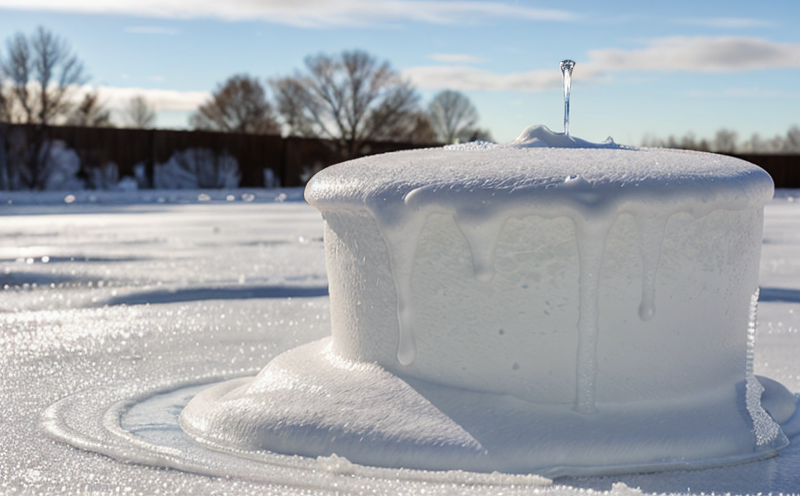EASA CS-E 790 Engine Icing Certification Testing
The European Aviation Safety Agency (EASA) CS-E 790 standard governs the certification process for engine ice protection systems. This rigorous testing ensures that aircraft engines can operate safely and reliably in icing conditions, a critical requirement for aviation safety.
Engine icing can lead to severe performance degradation, including thrust loss or even complete failure of the engine. The EASA CS-E 790 standard mandates comprehensive certification tests to verify that an engine's ice protection system functions effectively under specified icing conditions. This testing is essential for compliance with aviation regulations and ensures public safety.
The test procedure involves exposing the engine to a controlled environment where artificial ice crystals are created, simulating real-world icing conditions. The engine is then operated in this simulated environment to evaluate its response to ice accumulation on key components such as turbine blades, compressor vanes, and inlet ducts.
During testing, engineers closely monitor parameters like fuel flow, exhaust gas temperature (EGT), and engine pressure ratio (EPR) to assess the impact of icing. The test also evaluates the effectiveness of anti-icing systems, which may involve using bleed air or electrical heating elements to prevent ice formation on critical surfaces.
The EASA CS-E 790 standard specifies stringent acceptance criteria, ensuring that engines can maintain safe and efficient operation even under severe icing conditions. Compliance with this standard is mandatory for engine manufacturers aiming to obtain the necessary certification from EASA.
Our laboratory offers state-of-the-art facilities equipped with specialized equipment capable of simulating a wide range of icing scenarios. This includes variable temperature chambers, misting systems, and sophisticated data acquisition systems that provide real-time monitoring of test parameters.
The testing process is highly detailed and involves multiple stages to ensure comprehensive evaluation. Initially, the engine undergoes a baseline performance assessment without any ice protection measures in place. Subsequently, it is subjected to icing conditions while the anti-icing system is activated. Engineers then analyze the data collected during this phase to determine if the system meets the required performance criteria.
The test concludes with a post-test inspection of the engine components for any signs of damage or degradation due to icing. This visual inspection, combined with detailed performance data, provides a comprehensive evaluation of the engine's ice protection capabilities.
Our team of experts ensures that each test is conducted in strict adherence to EASA CS-E 790 standards. With years of experience and cutting-edge facilities, we provide reliable and accurate results that are essential for compliance with aviation regulations.
Scope and Methodology
| Parameter | Description |
|---|---|
| EASA CS-E 790 Compliance | The test ensures full compliance with EASA CS-E 790 standards for engine ice protection systems. |
| Icing Simulation Conditions | Artificial ice crystals are created in a controlled environment to simulate real-world icing conditions. |
| Engine Performance Monitoring | Critical parameters such as fuel flow, EGT, and EPR are continuously monitored during the test. |
| Anti-Icing System Evaluation | The effectiveness of anti-icing systems is evaluated to ensure safe operation under icing conditions. |
| Post-Test Inspection | A detailed inspection of engine components for signs of damage or degradation due to icing. |
| Data Analysis | Comprehensive analysis of test data to determine compliance with acceptance criteria. |
Why Choose This Test
The EASA CS-E 790 Engine Icing Certification Testing is crucial for engine manufacturers and operators aiming to comply with aviation regulations. By ensuring that engines can operate safely in icing conditions, this testing contributes significantly to flight safety.
Our laboratory provides comprehensive support throughout the testing process, from initial consultation to final reporting. With a team of experienced engineers and state-of-the-art facilities, we ensure accurate and reliable results that are essential for certification purposes.
The test is particularly beneficial for manufacturers developing new engine models or enhancing existing systems with ice protection features. It allows them to identify any potential issues early in the design process, ensuring that the final product meets stringent safety standards.
For operators, this testing provides peace of mind knowing that their engines are prepared for real-world icing conditions. By complying with EASA CS-E 790 standards, they can ensure safe and reliable operations, reducing the risk of engine failure and potential accidents.
The results of this test also serve as valuable data for ongoing research and development efforts aimed at improving ice protection systems. This continuous improvement cycle is essential in an industry that must constantly adapt to new challenges and regulations.
Environmental and Sustainability Contributions
Ensuring safe engine operation in icing conditions not only enhances flight safety but also contributes positively to environmental sustainability. By preventing engine failures due to ice accumulation, aircraft can maintain optimal fuel efficiency and reduce emissions during critical phases of flight.
The EASA CS-E 790 testing process is designed with sustainability in mind. The controlled environment used for icing simulation minimizes waste and resource consumption compared to real-world conditions. Additionally, the detailed performance data collected during these tests helps engineers optimize engine design, leading to more efficient operations and reduced environmental impact.
The results of this testing are also valuable for regulatory bodies and industry stakeholders working towards global aviation sustainability goals. By ensuring that engines can operate safely under all conditions, including icing, we contribute to the overall reduction in flight-related emissions and promote a safer and more sustainable aviation sector.





